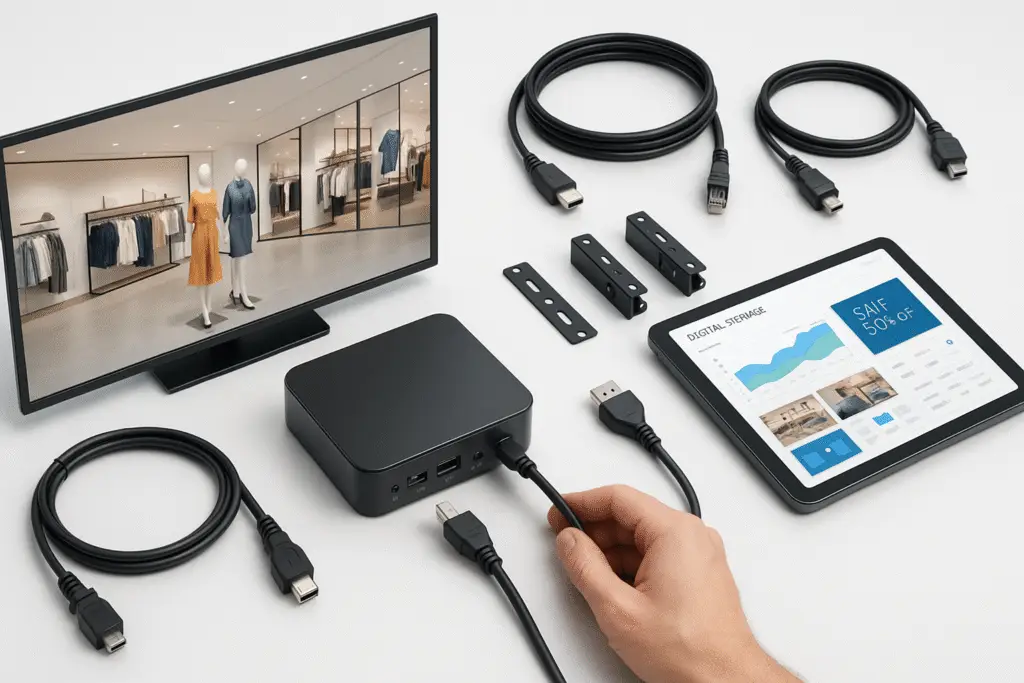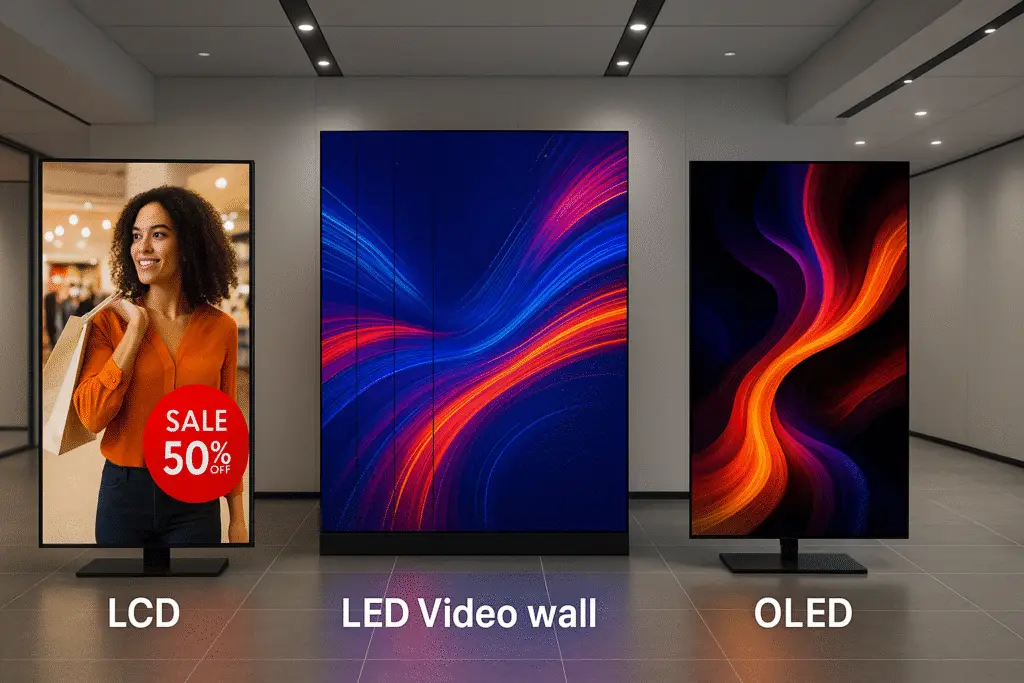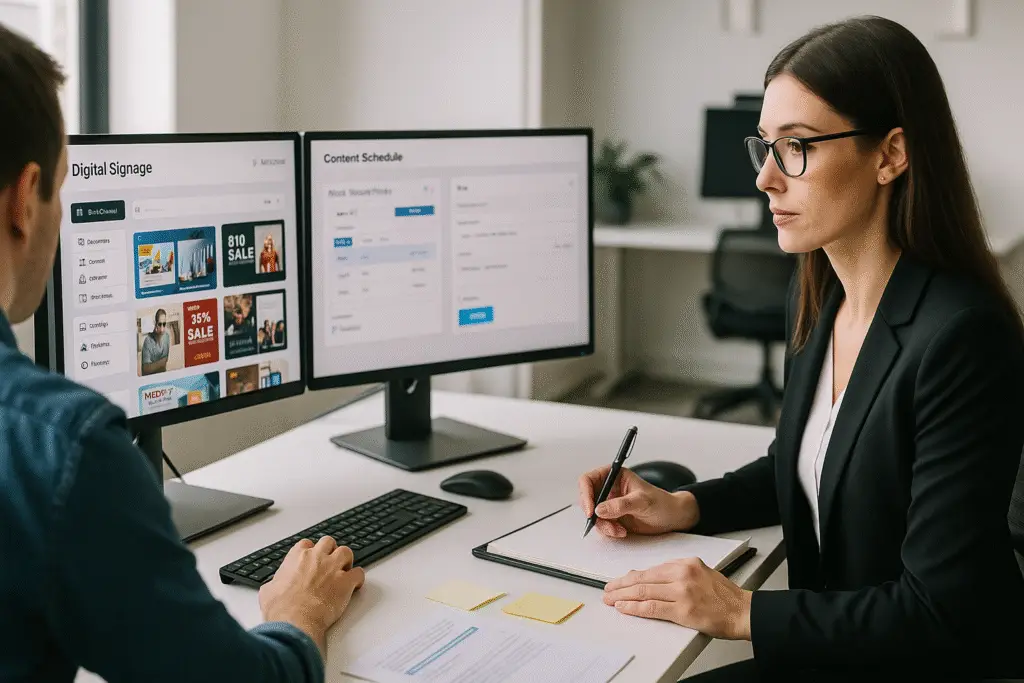If your digital signage hardware is an afterthought, you’re setting yourself up for a world of pixelated pain. Whether you’re firing up one screen in a quiet lobby or managing a coast-to-coast rollout, your digital signage hardware choices dictate how your content looks, runs, and survives in the real world.
This guide skips the fluff and goes straight to the good stuff. We’re talking must-have gear, smart tradeoffs, and how not to blow your budget on features you’ll never use.
What is Digital Signage Hardware?
Think of digital signage hardware as the engine room of your signage strategy. It’s not just “a screen on a wall.” It’s the whole cast of characters working behind the scenes to make your content show up, look sharp, and run without hiccups.
You’ve got digital signage players doing the thinking, digital signage displays doing the showing, mounts doing the heavy lifting, and network gear making sure everything talks to everything else. When all these parts work together, your signage doesn’t just work. It works well.
Here’s the core crew that makes it all happen:
Digital Signage Displays: The stage where your content performs
- Built to run for hours (or forever)
- Comes in all sizes, shapes, and brightness levels
- Designed for indoor calm or outdoor chaos
Digital Signage Players: The brains of the operation
- Decode and deliver your content
- Connect to your CMS and your screen
- Can be boxy, tiny, or baked right into the display (hello, SoC)
Mounting Solutions: The unsung heroes
- Wall, ceiling, floor. If it holds a screen, it counts
- Includes theft-deterring, tamper-proof options for public spaces
- Bonus points if it’s easy to service later
Get this foundation right, and your signage runs like clockwork. Get it wrong, and you’re stuck troubleshooting instead of communicating. Match your hardware to your content and environment, and you’ll spend less time babysitting your screens and more time watching them impress.

Digital Signage Displays: Your Complete Buying Guide
When people look at your digital signage, they’re not thinking about your media player or your Wi-Fi setup. They’re staring at the digital signage screen. That makes your display the face of your whole system. Like any good face, it needs to look sharp, perform under pressure, and hold up over time.
Here’s how the three main digital signage display types stack up in the real world:
LCD Digital Signage Displays
Where it shines: Indoors with calm lighting and budget-conscious projects.
Why choose LCD digital signage screens:
- Affordable up front
- Uses less power than other options
- Wide viewing angles mean no awkward neck craning
- Colors look great and stay consistent
- Comes in pretty much every size imaginable
What to watch for:
- Glare is a problem if lights are blasting overhead
- Doesn’t compete well with bright sunlight
- Not built for weather or extreme temps
- Big panels can run hot
LED Digital Signage Displays
Where it rules: Outdoors, big spaces, bold content. Think billboards, arenas, and video walls.
Why choose LED digital signage screens:
- Bright enough to fight the sun (10,000+ nits isn’t unheard of)
- Built to take a beating. Great in wind, rain, and everything else
- Modular setup means any size, any shape
- Energy efficient at scale
- Can run for years (we’re talking 100,000 hours+)
What to watch for:
- Higher price tag up front
- Maintenance is trickier (especially at height)
- Viewing distance matters. Get the wrong pixel pitch and it’ll look pixelated
- Heavier gear needs serious support
OLED Digital Signage Displays
Where it wows: Boutique retail, luxury spaces, or anywhere you want people to stop and stare.
Why choose OLED digital signage screens:
- Blacks are blacker than black. Seriously.
- Colors pop, contrast dazzles
- So thin it’s basically wallpaper
- Great from any angle
- Can do transparent or bendy screens for creative installs
What to watch for:
- Burn-in is a risk with static images (logos, menus, etc.)
- It’ll cost you. Definitely not the cheap option
- Smaller size options (you’re not building a stadium wall with OLED)
- Doesn’t last as long as LED
Bottom line? Choose your digital signage display like you’d choose a business partner: not for flash, but for fit. Your space, lighting, content, and audience should drive the decision, not just the spec sheet or the salesperson’s pitch.

Digital Signage Display Specs That Actually Matter
Once you’ve picked your digital signage screen type (LCD, LED, OLED), it’s time to talk specs. Specifically resolution, brightness, and durability. These aren’t just numbers on a datasheet. They’re the difference between a screen that impresses and one that gets ignored (or worse, returns).
Resolution & Size: How Sharp Do You Really Need It?
4K UHD Digital Signage Displays (3840 x 2160)
- Use it when: Viewers are close (within 6 feet) or content is detail-heavy
- Why it rocks: Crystal-clear text, future-proof for content upgrades, perfect for luxury branding
- Keep in mind: Needs beefier digital signage players and more bandwidth
1080p Full HD Digital Signage Screens (1920 x 1080)
- Use it when: Your audience is 6 to 12 feet away
- Why it works: Affordable, supported everywhere, ideal for retail, offices, and menus
- Good enough? For most cases, yes
720p HD Digital Signage Displays (1280 x 720)
- Use it when: You’re on a tight budget or screens are far away (12+ feet)
- Why it’s fine: Still gets the message across for basic info boards
- Don’t expect: Razor-sharp visuals or small readable text
Brightness Levels: Because Sunlight Doesn’t Care About Your Design
Brightness is measured in nits (yes, that’s the actual term), and it’s critical for digital signage display visibility. Too low, and your screen fades into the background. Too high, and you’re wasting power or cooking your hardware.
Here’s what to aim for:
- 300 to 500 nits: Dim indoor spots (think lobbies, conference rooms, museums)
- 500 to 700 nits: Bright indoor environments like retail or sunlit offices
- 700 to 2,500 nits: Window-facing displays that need to fight glare
- 1,500 to 2,500 nits: Outdoors but under cover (awnings, shade, partial sun)
- 2,500 to 5,000+ nits: Full-on sunlight exposure like transportation hubs, street signage
Pro Tip: Brighter isn’t always better. Match brightness to the actual lighting conditions, or you’ll burn through your energy budget (and your hardware’s lifespan).
Why “Commercial-Grade” Actually Means Something
That cheap 65-inch TV might look tempting, but using it for digital signage is like racing a go-kart in a demolition derby. Here’s what sets true commercial digital signage displays apart:
- 24/7 Ready: Built to run all day, every day (no burnout after 6 months)
- Portrait Mode Support: Mount vertically without voiding the warranty
- Heat Management: Better airflow, fewer surprise shutdowns
- Anti-Burn Protection: Avoids ghost images on screen
- Tamper Controls: Lock out buttons and ports so no one gets creative
- More Ports, More Control: RS-232, HDMI loops, remote monitoring, you name it
- Better Warranties: Designed for actual business use, not binge-watching Netflix
Specs matter, but only when they match your real-world use case. Don’t buy the biggest, brightest, sharpest digital signage display just because it sounds cool. Buy what works where your screen is going to live and lasts while it does it.
Digital Signage Players: The Heart of Your Network

Your digital signage player is the silent workhorse of your digital signage network. They decode your content, drive your displays, and either keep your signage humming or drive you nuts with glitches and black screens. Choose wisely.
Here’s the lowdown on the three main types of digital signage media players: when to use them, why they’re great, when they’re not, and which brands are worth your attention.
Standalone Digital Signage Media Players
Purpose-built boxes designed just for digital signage. No fluff, no bloat. Just focused functionality.
Why choose standalone digital signage players:
- Plug-and-play simplicity with rock-solid uptime
- Easy to replace without unmounting your display
- Compatible with most CMS platforms
Why not:
- Adds cable clutter and needs extra power
- Limited processing power vs full PCs
- Not ideal for advanced interactivity or heavy data use
Best for: General signage, retail, QSR, lobbies, and anyone who values reliability over bells and whistles
Popular picks:
- BrightSign Series – industry standard, incredibly reliable
- Intel NUC – compact powerhouse, great for HD/4K playback
- Chromebox Commercial – secure, cloud-first, Google ecosystem
- Navori StiX – sleek Android-based player built for pro signage
System-on-Chip (SoC) Digital Signage Players
The no-box solution. Processing power built right into the digital signage display. Sleek and simple. What’s not to like?
Why choose SoC digital signage devices:
- No external hardware = cleaner installs, fewer cables
- Lower total cost of ownership (especially at scale)
- Ideal for non-interactive content and scheduled playlists
Why not:
- Locked into that display’s OS (Samsung ≠ LG ≠ Sony)
- Limited performance for complex content or integrations
- Harder to replace or upgrade without swapping the entire screen
Best for: Menu boards, retail store rollouts, corporate communications, and content that doesn’t change every 5 minutes
PC-Based Digital Signage Media Players
The “go big or go home” option. These digital signage devices can do just about anything if your content strategy demands it.
Why choose PC-based digital signage players:
- Supports multi-zone layouts, interactivity, real-time data, and custom software
- Expandable storage and upgrade options
- Perfect for video walls, kiosks, and analytics-heavy environments
Why not:
- Larger footprint = more heat, higher energy draw, more fan noise
- Often overkill for basic signage needs
- Higher upfront and maintenance costs (especially Windows-based setups)
Best for: Touchscreens, interactive wayfinding, control rooms, multi-screen environments, and power users
Popular picks:
- Windows Mini PCs – for full CMS flexibility and interactive use
- Linux-Based Boxes – stable, secure, and great for kiosk-type setups
- Custom-Built Rigs – if you’re running high-end visuals or multi-screen madness
What to Look for in the Best Digital Signage Player
The digital signage media player is the unsung hero (or silent troublemaker) of any digital signage setup. You don’t need to obsess over every tiny spec, but getting the basics right can save you a ton of headaches later. Here’s a no-BS checklist of what to actually look for, whether you’re buying your first digital signage player or upgrading for serious scale.
Processing Power for Digital Signage Players
- CPU: At least a quad-core processor (i3/i5 or ARM if you’re going light)
- RAM: 4GB minimum. Go 8GB+ for 4K or anything interactive
- Storage: 32GB SSD at least. Use industrial-grade if it’s going outdoors or into dusty places
- GPU: Dedicated graphics card for video walls or smooth motion-heavy content
Connectivity for Digital Signage Devices
- Video Out: HDMI 2.0+ or DisplayPort (if you’re chaining displays)
- USB Ports: You’ll want USB 3.0 or higher. More is better
- Network: Gigabit Ethernet is safest. Wi-Fi 6 or 5G if you’re going wireless or remote
- Extras:
- RS-232 (for legacy control)
- GPIO (for motion sensors, triggers)
- Bluetooth (for peripherals or beacons)
Operating System for Digital Signage Players
- Windows: Compatible with almost everything. Great for touchscreens. Higher cost.
- Android: Low-cost, mobile-style OS. Great for simple playback.
- Linux: Secure and stable, perfect for single-purpose signage.
Temperature & Protection for Digital Signage Hardware
- Active cooling and proper airflow = longer lifespan
- Heaters for extreme cold installs
- Thermal sensors for remote monitoring
- IP54 to IP65 enclosures for dust, water, or busy public spaces
- Anti-corrosion coatings for coastal areas
- Impact-resistant casings if they’re within kicking range
Energy Efficiency
- Auto shutdowns when the store’s closed
- Sensors to dim or sleep when no one’s around
- LED backlights and low-watt processors to save power
- Energy Star certified gear where possible
The Smart Takeaway: Your digital signage media player isn’t just a black box. It’s the command center of your signage setup. Choose one that matches your content complexity, environment, and support needs. Go too cheap, and you’ll be rebooting it more than your laptop. Go too powerful, and you’re just burning cash and electricity.
Need Help Choosing Hardware?
Expert Tips & Best Practices for Digital Signage Hardware

You can buy the best digital signage hardware on the market, but if your install is rushed, your content strategy is half-baked, or you forget airflow exists, you’re setting yourself up for headaches. Here’s how to plan smart from the start.
Before You Drill a Single Hole: Do a Site Survey
A good install starts with a solid walkthrough. Bring a checklist, not just a measuring tape.
Your must-check list:
- Power: Enough outlets, right voltage, dedicated circuits
- Network: Reliable Wi-Fi or wired connection with proper bandwidth
- Mounting Surface: Studs? Cement? Drywall? Know before you drill
- Ambient Light: Check throughout the day, not just at 10 a.m.
- Viewing Angles: How tall is your audience? What’s the traffic flow?
- Environment: Heat, humidity, dust, and anything else that kills electronics
- Security: Can someone unplug it, steal it, or mess with it?
Match Your Digital Signage Hardware to Your Content Strategy
Don’t let the tech lead your content. Your messaging plan should drive the digital signage hardware, always.
Ask yourself:
- What formats will you use? Video? Live data? Just a few images?
- How often will content change? Hourly? Weekly? Quarterly?
- Is the screen interactive? Will it use touch, motion sensors, or external triggers?
- Do you need emergency override messaging (fire alerts, safety info)?
- Will it integrate with POS, scheduling tools, or other internal systems?
- Are you measuring anything? Impressions, dwell time, engagement?
Plan for Maintenance Like It’s Inevitable (Because It Is)
Even the best digital signage hardware needs occasional TLC. Planning for it beats scrambling when something breaks.
Your maintenance game plan:
- Clean regularly: Dust kills airflow, and smudged digital signage screens look terrible
- Monitor performance: Use software that flags issues early
- Stay updated: Don’t ignore firmware and OS updates. They fix more than bugs
- Prep for emergencies: Know what to do if the screen goes dark
- Document everything: Serial numbers, logins, configurations
- Train your team: They don’t need to be experts, but they should know what to reboot
Avoid These Rookie Mistakes
These are the things that separate a clean install from a tech support nightmare:
- Too-dim digital signage displays: Especially in bright areas or window-facing installs
- Consumer TVs: Great for your living room, terrible for your 12-hour signage loop
- No ventilation plan: Leads to hot boxes and early hardware death
- Cable spaghetti: Makes service harder and creates fire hazards
- No backups: One digital signage player dies and you’re down for days? Not good.
- No futureproofing: Can your setup grow with you?
- Stale content: If it hasn’t changed since last quarter, people have stopped looking
- Mounting too high or too low: If it hurts your neck, it’s wrong
Pro Tip: A successful digital signage hardware install is like a good stage production. The tech should disappear, and the message should shine. Planning, testing, and attention to detail are what make that possible.
Emerging Trends in Digital Signage Hardware (2025)
The digital signage hardware world doesn’t stand still, and neither should you. From smarter digital signage screens to data-driven displays, here’s what’s shaping the future of digital signage hardware in 2025 and beyond.
System-on-Chip (SoC) Digital Signage Displays
The all-in-one workhorse is becoming the norm.
Why it matters: As SoC performance improves, more brands are ditching external digital signage media players entirely. It’s cheaper, cleaner, and getting more capable by the year.
What’s new:
- Processing power built directly into the digital signage screen
- Fewer moving parts = fewer points of failure
- Easier deployment and centralized management
- Great for scale: retail, QSR, corporate networks
Transparent & Flexible Digital Signage Displays
Digital signage screens that don’t look like screens. Perfect for design-driven spaces.
Why it matters: These displays blend into environments, wrapping around columns, floating in windows, or morphing into product showcases.
What’s possible:
- Transparent glass displays for retail or museums
- Curved and bendable screens for creative installs
- Seamless architectural integration
- Digital overlays on real-world objects
AI-Powered Digital Signage Hardware
Smarter digital signage devices aren’t coming. They’re already here.
Why it matters: AI is driving everything from energy savings to personalized content, and it’s all happening inside the digital signage hardware.
What AI is doing:
- Detecting age, gender, and mood (anonymously) for content targeting
- Adjusting brightness and messaging based on time of day or viewer
- Predicting hardware issues before they happen (goodbye, downtime)
- Managing power use dynamically to cut costs and boost sustainability
Programmatic DOOH-Ready Digital Signage Hardware
Your signage is becoming part of the ad tech stack.
Why it matters: As programmatic DOOH grows, digital signage displays need to support real-time ad delivery, measurement, and automation natively.
What’s evolving:
- Real-time bidding (RTB) integration at the digital signage player/display level
- Built-in sensors or cameras for impression verification
- Content that reacts to local triggers: weather, traffic, or foot traffic
- Geofenced mobile notifications that sync with on-screen content
Final Thought: These trends aren’t just futuristic buzzwords. They’re already hitting pilot programs and mainstream rollouts. If you’re planning new installs (or replacing legacy gear), now’s the time to future-proof your digital signage hardware. Buy smart, scale smarter.

Digital Signage Hardware: Your Action Plan
There’s no one-size-fits-all when it comes to digital signage hardware. What works for a quiet lobby display won’t cut it in a sun-blasted storefront or a busy transit hub. Getting it right means balancing performance, durability, and cost with a clear-eyed view of your environment and content needs.
Yes, it takes planning. But the payoff? A signage network that looks sharp, runs smooth, and scales when you need it to without turning into a tech support nightmare.
Remember: Your digital signage screens are part of your brand. The hardware behind them should support your message, not sabotage it.
Your Next Moves (If You’re Serious About Doing This Right)
✅ Assess your environment – Power, lighting, traffic flow. Get the lay of the land before you buy anything.
✅ Request demos – Test digital signage media players and displays with your content. Specs are helpful. Real-world performance is better.
✅ Plan in phases – Pilot first. Scale with confidence.
✅ Build your content strategy in parallel – Don’t wait until install day to ask, “What are we putting on these screens?”
✅ Define success metrics – Is it foot traffic? Sales lift? Reduced wait times? Know what winning looks like.
The truth is, great signage doesn’t happen by accident. It’s engineered. With the right digital signage hardware foundation in place, you’ll be set up to inform, influence, and inspire your audience every single day. And if you’re ever unsure, a second opinion from a digital signage consultant (hey, I know a few) is always a smart call.
Learn more in my full Digital Signage Hardware insights archive
Need Help Choosing Hardware?
FAQ
What are the key factors to consider when choosing digital signage displays?
When selecting a digital signage display, consider brightness (measured in nits), screen size, resolution, location (indoor vs. outdoor), and durability. Outdoor displays should be weather-resistant and bright enough to remain visible in direct sunlight.
How important is the digital signage player in the overall setup?
The media player is essential—it powers your content. A good player ensures smooth playback, supports high-res videos, connects with your CMS, and handles updates reliably. It’s the engine behind your signage.
What type of connectivity should I look for in digital signage hardware?
Look for Ethernet and Wi-Fi for network reliability, plus HDMI or DisplayPort for video output. USB ports are useful for local content or peripherals. Versatile connectivity makes setup and maintenance easier.


